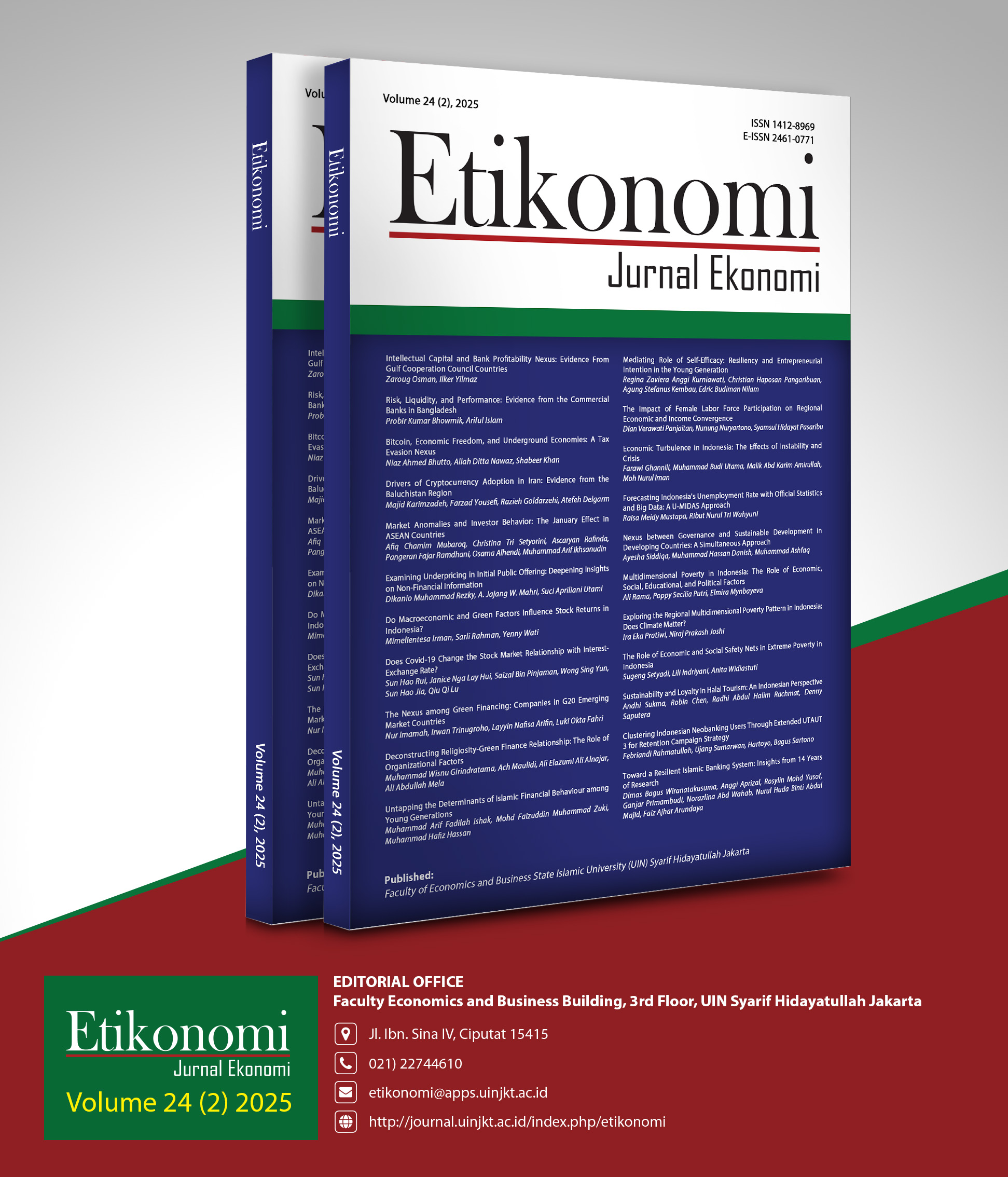Does Covid-19 Change The Stock Market Relationship With Interest-Exchange Rate?
DOI:
https://doi.org/10.15408/etk.v24i2.45853Keywords:
Auto Regressive Distributed Lag model, Covid-19, stock priceAbstract
Research Originality: Despite numerous studies conducted on similar topics, this study uniquely examines the short- and long-run dynamics of the interest rate, exchange rate, and stock prices in China under two distinct epochs: pre- and Covid-19 periods.
Research Objectives: This study compares the impact of interest and exchange rates on the Chinese stock market during the COVID-19 and pre-COVID-19 periods. Furthermore, the study also investigated the speed of adjustment towards equilibrium following short-run shocks in the stock market.
Research Method: This study employs monthly data on the Chinese stock market and the autoregressive distributed lag model-error correction model (ARDL-ECM) approach on a separate period.
Empirical Results: On COVID-19, the interest rate and exchange rate are not jointly and individually cointegrated significantly in explaining the stock prices. Nevertheless, the short-run relationship is identified as significant for both variables. Meanwhile, during COVID-19, the variables are jointly significant, with the exchange rate also identified to explain the stock market movement in the long run individually. In the short run, despite the greater impact of the exchange rate, the interest rates have a hysteretic impact.
Implications: The findings suggested that policymakers should leverage the exchange rate instrument as a better predictive tool in devising effective future policy-making.
JEL Classification: C320, G11, G15
Downloads
References
Androniceanu, A., Georgescu, I., Nica, I., & Chiriță, N. (2023). A Comprehensive Analysis of Renewable Energy Based on Integrating Economic Cybernetics and The Autoregressive Distributed Lag Model—The Case of Romania. Energies, 16(16), 5978.
Alimi, A. S., & Adediran, I. A. (2023). A New Look at Stock Price-Exchange Rate Nexus: Analysis of COVID-19 Pandemic Waves in Advanced and Emerging Economies. Scientific African, 20, e01671. https://doi.org/10.1016/j.sciaf.2023.e01671.
Assefa, T. A., Esqueda, O. A., & Mollick, A. V. (2017). Stock Returns and Interest Rates Around the World: A Panel Data Approach. Journal of Economics and Business, 89, 20-35. https://doi.org/10.1016/j.jeconbus.2016.10.001.
Adebayo, T. S., Akinsola, G. D., Kirikkaleli, D., Bekun, F. V., Umarbeyli, S., & Osemeahon, O. S. (2021). Economic Performance of Indonesia Amidst CO2 Emissions and Agriculture: A Time Series Analysis. Environmental Science and Pollution Research, 28(35), 47942-47956.
Bhattacharjee, A., & Das, J. (2023). Assessing The Long-Run and Short-Run Effect of Monetary Variables on Stock Market in The Presence of Structural Breaks: Evidence from Liberalized India. IIM Ranchi Journal of Management Studies, 2(1), 70-81. https://doi.org/10.1108/IRJMS-03-2022-0034.
Bahmani-Oskooee, M., & Saha, S. (2018). On The Relation Between Exchange Rates and Stock Prices: A Non-Linear ARDL Approach and Asymmetry Analysis. Journal of Economics and Finance, 42, 112-137. https://doi.org/10.1007/s12197-017-9388-8.
Baker, S. R., Bloom, N., Davis, S. J., Kost, K. J., Sammon, M. C., & Viratyosin, T. (2020). The Unprecedented Stock Market Impact of COVID-19. National Bureau of Economic Research Working Paper 26945. DOI 10.3386/w26945.
Bhargava, V., & Konku, D. (2023). Impact of Exchange Rate Fluctuations on US Stock Market Returns. Managerial finance, 49(10), 1535-1557. https://doi.org/10.1108/MF-08-2022-0387.
Chowdhury, E. K., Dhar, B. K., & Stasi, A. (2022). Volatility of the US Stock Market and Business Strategy During COVID‐19. Business Strategy & Development, 5(4), 350-360. https://doi.org/10.1002/bsd2.203.
Cox, J., Greenwald, D. L., & Ludvigson, S. C. (2020). What Explains The COVID-19 Stock Market? National Bureau of Economic Research Working Paper 27784. DOI 10.3386/w27784.
Endres, E. J. E. (2020). Impact of Macroeconomic Factors on Stock Market: Empirical Evidence from the Philippines. International Journal of Research Publications, 50(1), 01-12.
E'zazi, M. E., & Sadegh, S. H. (2015). An Investigation of Short-and Long-Term Impacts of Foreign Exchange Rate Fluctuations on Stock Index Revenue at the Tehran Stock Exchange Using ARDL Model. Asian Journal of Research in Banking and Finance, 5(3), 49-55. https://doi.org/10.5958/2249-7323.2015.00043.7.
El ABED, R., & Zardoub, A. (2019). Exploring The Nexus Between Macroeconomic Variables and Stock Market Returns in Germany: An ARDL Co-Integration Approach. Theoretical & Applied Economics, 2(2), 111-120.
Fang, F., Dong, W., & Lv, X. (2016). Asymmetric Reactions of China’s Stock Market to Short-Term Interest Rates. International Journal of Economics and Finance, 8(5), 260-270. https://doi.org/10.5539/ijef.v8n5p260.
Gong, P., & Dai, J. (2017). Monetary Policy, Exchange Rate Fluctuation, And Herding Behavior in The Stock Market. Journal of Business Research, 76, 34-43. https://doi.org/10.1016/j.jbusres.2017.02.018.
Goh, T. S., & Henry Henry, E. E. (2024). Factors Impact of the Stock Market Performance During the Covid-19 Crisis. Etikonomi, 23(1), 47-62. https://doi.org/10.15408/etk.v23i1.32005.
Gao, X., Ren, Y., & Umar, M. (2022). To What Extent Does COVID-19 Drive Stock Market Volatility? A Comparison Between the US and China. Economic Research-Ekonomska Istraživanja, 35(1), 1686-1706. https://doi.org/10.1080/1331677X.2021.1906730.
Guan, X., Zhou, M., & Zhang, M. (2015). Using The ARDL-ECM Approach to Explore The Nexus Among Urbanization, Energy Consumption, and Economic Growth in Jiangsu Province, China. Emerging Markets Finance and Trade, 51(2), 391-399.
Hu, J., Jiang, G. J., & Pan, G. (2020). Market Reactions t Central Bank Interest Rate Changes: Evidence from the Chinese Stock Market. Asia‐Pacific Journal of Financial Studies, 49(5), 803-831. https://doi.org/10.1111/ajfs.12316.
He, Q., Liu, J., Wang, S., & Yu, J. (2020). The Impact Of COVID-19 On Stock Markets. Economic and Political Studies, 8(3), 275-288.
Ikhsan, S., Putra, T. A. P. S., Sugiyanto, S., Dasuki, R., & Herdiansyah, E. (2022). The Effect of Exchange Rate and Interest Rate on Share Prices in The Manufacturing Sector with Inflation as Moderation. JRAK, 14(2), 226-236.
Javangwe, K. Z., & Takawira, O. (2022). Exchange Rate Movement and Stock Market Performance: An Application of The ARDL Model. Cogent Economics & Finance, 10(1), 1-20. https://doi.org/10.1080/23322039.2022.2075520.
Khan, M. K., Teng, J. Z., Parviaz, J., & Chaudhary, S. K. (2017). Nexuses between Economic Factors and Stock Returns in China. International Journal of Economics and Finance, 9(9), 182-191.
Lee, C. C., Lee, C. C., & Wu, Y. (2023). The Impact Of COVID‐19 Pandemic on Hospitality Stock Returns in China. International Journal of Finance & Economics, 28(2), 1787-1800.
Liu, H., Manzoor, A., Wang, C., Zhang, L., & Manzoor, Z. (2020). The COVID-19 Outbreak and Affected Countries Stock Markets Response. International Journal of Environmental Research and Public Health, 17(8), 2800. https://doi.org/10.3390/ijerph17082800.
Liu, H., Wang, Y., He, D., & Wang, C. (2020). Short Term Response of Chinese Stock Markets to The Outbreak Of COVID-19. Applied Economics, 52(53), 5859-5872.
Liu, T. Y., & Lee, C. C. (2022). Exchange Rate Fluctuations and Interest Rate Policy. International Journal of Finance & Economics, 27(3), 3531-3549. https://doi.org/10.1002/ijfe.2336.
Musawa, N., & Mwaanga, C. (2017). The Impact of Commodity Prices, Interest Rate and Exchange Rate on Stock Market Performance: Evidence from Zambia. Journal of Financial Risk Management, 6(03), 300-313. https://doi.org/10.4236/jfrm.2017.63022.
Nurmasari, I., & Nur'aidawati, S. (2021). The Effects of Inflation, Interest Rates and Exchange Rates on Composite Stock Price Index During The Covid-19 Pandemic. Jurnal Mandiri: Ilmu Pengetahuan, Seni, dan Teknologi, 5(2), 77-85. https://doi.org/10.33753/mandiri.v5i2.178.
Neifar, M. (2023). Macroeconomic Factors and UK Stock Market: Evidence Through the Non-Linear ARDL Model. MPRA Paper 116298.
Nwosa, P. I. (2021). Oil Price, Exchange Rate and Stock Market Performance During The COVID-19 Pandemic: Implications for Tncs and FDI Inflow in Nigeria. Transnational Corporations Review, 13(1), 125-137. https://doi.org/10.1080/19186444.2020.1855957.
Nguyen, V. H. (2019). Dynamics Between Exchange Rates and Stock Prices: Evidence from Developed and Emerging Markets. The International Journal of Business and Finance Research, 13(1), 73-84. https://doi.org/10.1016/j.iref.2013.02.004.
Pokhrel, L., & Mishra, A. K. (2020). The Dynamic Linkage Between Interest Rates and Stock Prices: An Application of ARDL Bound Test. NOLEGEIN Journal of Financial Planning and Management, 3(1). https://doi.org/10.37591/njfpm.v3i1.466.
Qing, Y. K., & Kusairi, S. (2019). The Effect of Money Supply, Exchange Rate, And Interest Spread Toward the Performance of Stock Market in Malaysia. Widyakala Journal, 6(2), 142-149. https://doi.org/10.36262/widyakala.v6i2.217.
Rahmayani, D., & Oktavilia, S. (2020). Does The Covid-19 Pandemic Affect the Stock Market in Indonesia. Jurnal Ilmu Sosial dan Ilmu Politik, 24(1), 33-47.
Rai, K., & Garg, B. (2022). Dynamic Correlations and Volatility Spillovers Between Stock Price and Exchange Rate in BRICS Economies: Evidence from the COVID-19 Outbreak Period. Applied Economics Letters, 29(8), 738-745. https://doi.org/10.1080/13504851.2021.1884835.
Sajor, B., Ulla, A., & Pizzaro-Uy, A. C. (2023). Impact of Macroeconomic Variables on Stock Market Price Levels: Evidence from the Philippines. Journal of Economics, Finance and Accounting Studies, 5(2), 116-138. https://doi.org/10.32996/jefas.2023.5.2.10.
Sia, P. C., Puah, C. H., Leong, C. M., Yii, K. J., & Tang, M. M. J. (2025). Does Inflation or Interest Rate Matter to Indonesian Stock Prices? An Asymmetric Approach. Journal of Economics and Development, 27(1), 72-86. https://doi.org/10.1108/JED-07-2024-0239.
Tabash, M. I., Babar, Z., Sheikh, U. A., Khan, A. A., & Anagreh, S. (2022). The Linkage Between Oil Price, Stock Market Indices, And Exchange Rate Before, During, and After COVID-19: Empirical Insights of Pakistan. Cogent Economics & Finance, 10(1), 2129366. https://doi.org/10.1080/23322039.2022.2129366.
Türsoy, T. (2017). Causality Between Stock Prices and Exchange Rates in Turkey: Empirical Evidence from The ARDL Bounds Test and A Combined Cointegration Approach. International Journal of Financial Studies, 5(1), 8. https://doi.org/10.3390/ijfs5010008.
Türsoy, T. (2019). The Interaction Between Stock Prices and Interest Rates in Turkey: Empirical Evidence from ARDL Bounds Test Cointegration. Financial Innovation, 5(1), 1-12. https://doi.org/10.1186/s40854-019-0124-6.
Tan, X., Ma, S., Wang, X., Zhao, Y., Wang, Z., & Xiang, L. (2022). The Dynamic Impact Of COVID-19 Pandemic on Stock Returns: A TVP-VAR-SV Estimation for G7 Countries. Frontiers in Public Health, 10, 859647.
Tian, Y., Chen, W., & Zhu, S. (2017). Does Financial Macroenvironment Impact on Carbon Intensity: Evidence From ARDL-ECM Model in China. Natural Hazards, 88, 759-777.
Wang, R., & Li, L. (2020). Dynamic Relationship Between the Stock Market and Macroeconomy in China (1995–2018): New Evidence from The Continuous Wavelet Analysis. Economic Research-Ekonomska Istraživanja, 33(1), 521-539. https://doi.org/10.1080/1331677X.2020.1716264.
Downloads
Published
Issue
Section
License
Copyright (c) 2025 Haorui SUN

This work is licensed under a Creative Commons Attribution-ShareAlike 4.0 International License.










